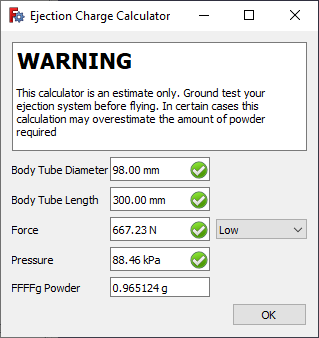Rocket Ejection Charge Calculator/de
|
|
| Menüeintrag |
|---|
| Rakete → Rechner → Ausstoß-ladungs-Rechner |
| Arbeitsbereich |
| Arbeitsbereich Rocket |
| Standardtastenkürzel |
| Keiner |
| Eingeführt in Version |
| 0.19 |
| Siehe auch |
| Keiner |
Beschreibung
Der Auswurf erfolgt, wenn die Kammer, in der sich das Bergungssystem befindet, mit ausreichender Kraft unter Druck gesetzt wird, um das Bergungssystem aus der Kammer auszustoßen. Die erforderliche Kraft kann aufgrund einer Reihe von Faktoren variieren:
- Durchmesser und Volumen des Rumpfrohrs
- Masse der Nase und des Wiederherstellungssystem
- Ausstoßverfahren, beispielsweise Kolbensysteme erfordern weniger Druck
- Vorhandensein von Scherstiften zur Verhinderung von Schleppablösung
- Passform des Wiederherstellungssystems im Rumpfrohr
As such, this calculator will only give you a starting estimate. Too little powder will result in a failed ejection and a failed recovery. Too much powder may result in damage to the rocket or recovery system, which may also result in a failed recovery. It is ALWAYS necessary to do a ground test before flying your rocket.
When calculating the volume of the body tube, it is rarely necessary to include the full length. For example, the shoulder of the nose or electronics bay may consume some volume. Adjust your length specification accordingly.
There are some rules of thumb that can be applied based on years of experience from multiple rocket builders. Of primary concern here is the force applied to the ejectable portion, typically the nose cone or electronics bay. Ejection forces at this interface should be between 150 and 200 lbf (~667 to 890 N). The pressure required can then be calculated based on the volume of the chamber. This pressure will be less for larger diameters and more for smaller diameters. There are presets in the calculator to set these forces (low and high settings in the combobox).
Ground testing should start at the low end of the recommended range to prevent damage to your rocket. Increase the amount as required to ensure safe recovery.
Anwendung
- There are several ways to invoke the command:
- Press the
Ejection Charge Calculator button.
- Select the Rocket → Calculators →
Ejection Charge Calculator option from the menu.
- Press the
- Enter the weight of your rocket and parameters for your parachute.
Berechnung
Pressure is set by desired force, or force can be set by specifying the desired pressure. This is based on the force applied to the area at the end of the volume to be pressurized.
where
- desired force
- body tube diameter
- desired force
Once the desired pressure is known, the amount of black powder can be calculated using
where
- the pressure calculated in the previous equation
- the volume of the chamber to be pressurized
- , combustion gas constant for FFFFg black powder
- , combustion gas temperature
- , acceleration due to gravity
- the pressure calculated in the previous equation
Einheiten
Calculations are done using metric units, but will display in your preferred units. Values can also be entered using any supported units by including the units with the value (eg 5 oz, or 23.2 g)
Referenzen
- http://vernk.com/EjectionChargeSizing.htm
- https://www.insanerocketry.com/blackpowder.html
- https://rocketrycalculator.com/rocketry-calculator/bp-estimator
- http://www.rockethead.net/black_powder_calculator.htm
- http://hararocketry.org/hara/resources/how-to-size-ejection-charge/
- Erste Schritte
- Installation: Herunterladen, Windows, Linux, Mac, Zusätzliche Komponenten, Docker, AppImage, Ubuntu Snap
- Grundlagen: Über FreeCAD, Graphische Oberfläche, Mausbedienung, Auswahlmethoden, Objektname, Voreinstellungseditor, Arbeitsbereiche, Dokumentstruktur, Objekteigenschaften, FreeCAD unterstützen, Spenden
- Hilfe: Anleitungen, Videoanleitungen
- Arbeitsbereiche: Std Base, Arch, Assembly, BIM, CAM, Draft, FEM, Inspection, Material, Mesh, OpenSCAD, Part, PartDesign, Points, Reverse Engineering, Robot, Sketcher, Spreadsheet, Surface, TechDraw, Test Framework
